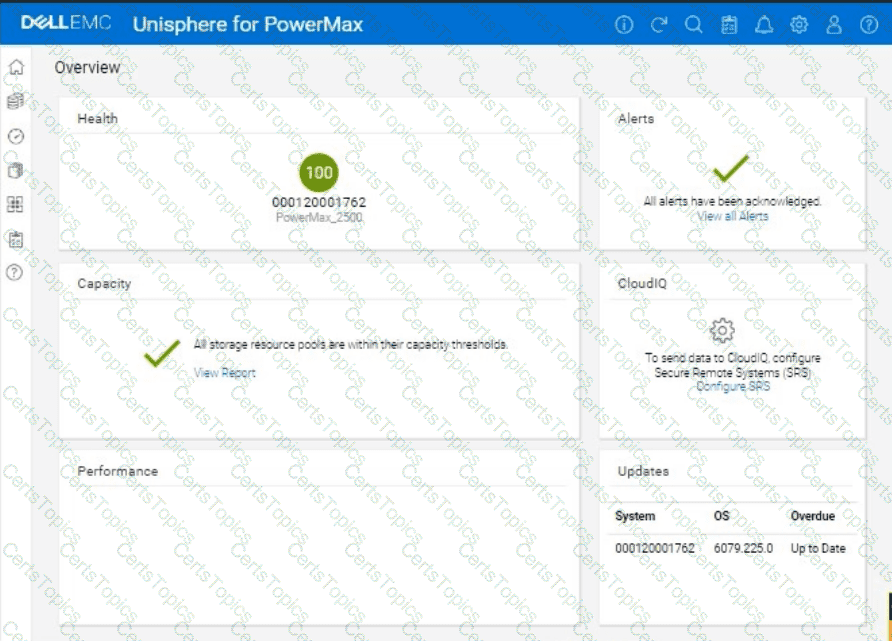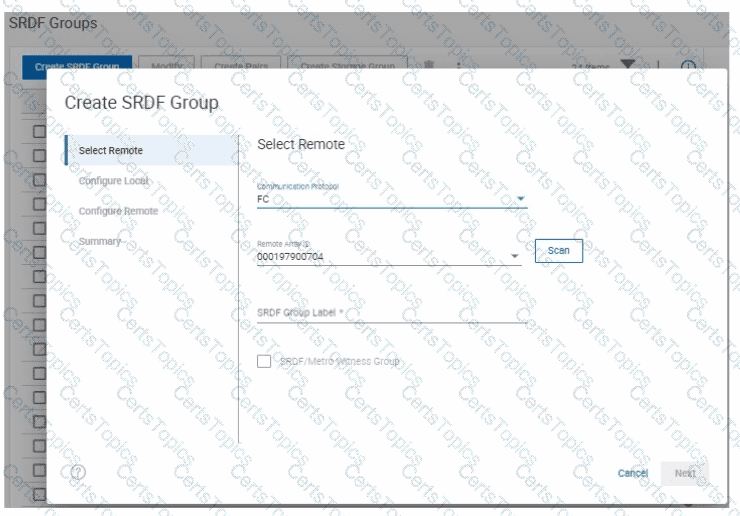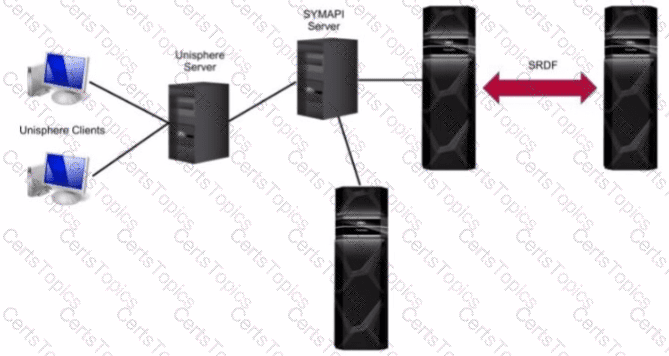SRDF/A has been enabled between two PowerMax arrays in Multi-Session Consistency mode An extended loss of all RDF links occurs. What will the RDF pair states be after link connectivity is restored?
How can TimeFinder SnapVX snapshots be scheduled?
Data is written on a source track and the original data needs to be preserved for a snapshot. Which technology does TimeFinder SnapVX use to prevent a new write from being demoted to a lower tier?
A systems administrator uses the symrdf createpair command to create an R1/R2 pair. Both devices are dynamic SRDF devices.
What is the default mode of operation for the SRDF pair when the Establish operation is performed?
How does Solutions Enabler use Gatekeepers to pass commands to the PowerMax array?
What is the maximum number of supported cascaded Storage Group levels in PowerMax and VMAX Family arrays?
When using TimeFinder SnapVX, why would a redirection-write be changed to a copy-on-write?
A systems administrator wants to move an application to VMAX3 storage. The application being migrated has no performance information available, including response time and average I/O size.
Based on Dell Technologies’ recommendations, which service level should be assigned?
When setting Host I/O Limits on a Storage Group, what are the available dynamic I/O distribution modes?
Which Solutions Enabler daemon is responsible forGatekeepermanagement?
A TimeFinder SnapVX snapshot of a Storage Group was created with a time to live setting of seven days Fourteen days after snapshot creation a query shows that the snapshot still exists. What is a possible reason for this issue?
A non-production environment has been created with a VMFS Datastore named TestDS and a virtual machine named TestVM. SRDF/S has been configured between two PowerMax arrays One ESXi server is connected to the R1 device and another is connected to the R2 device. The VMFS Datastore resides on the R1 device. The systems administrator wants to test the environment for disaster recovery readiness To simulate a disaster on the R1 side a graceful failover will be done. What is the correct sequence of steps on the R1 side of the test environment to perform a graceful failover?

What would the RDF device and Link states be after an SRDF Update operation?
Which Open Replicator device type resides on the array running Open Replicator?
SRDF/A has been enabled between two VMAX3 arrays. What will the RDF pair state be if there is a permanent loss of all RDF links?
Two PowerMax arrays have been configured for replication using SRDF During a disaster recovery operation production has been transferred to the R2 devices at the target site
Which operation allows the primary hosts to access the R1 devices without waiting for a data transfer to complete from the R2 devices'?
In PowerMax VMAX All Flash and VMAX3 which thin provisioning component can be changed with SYMCLI or Unisphere?
Where are the Host l/Os directed to when the Storage Group is in a Non-Disruptive Migration CutoverReady state?
A host is connected to two PowerMax arrays with SRDF/Metro Host l/Os cannot be delivered across the SRDF link. The devices in the SRDF group have been forced into a Not Ready state to the host Which attribute is set on the SRDF group to cause this behavior?
Which compression algorithm is used on a PowerMax?
What is the performance metric for the read-to-write ratio of workloads on a specific logical block address?
When reviewing storage group compliance for a specific storage group, you notice that the weighted response time for the storage group over the last four hours is compliant Upon further research, you see that the weighted response time for the last two weeks does not meet the defined response time for the assigned service level.
What is the overall compliance status for the storage group?
An SRDF/Metro pair was created with vWitness After a network outage, the administrator discovers that the SRDF pair is in an ActiveBias state What is the correct sequence of events to bring the SRDF pair into an ActiveActive state?

A company is preparing for a major product launch and a quarterly compliance audit. Perform a system health check to ensure that the storage array with SID - 1762 is functioning optimally, and also review the compliance status, generate and download the compliance report for all SGs.

Use the simulator to complete these tasks.
Which service has to be manually started first when Unisphere services are down?
Two PowerMax arrays have been configured for replication using SRDF During a disaster recovery operation production has been transferred to the R2 devices at the target site. Which operation begins the transfer of accumulated invalid tracks from the R2s to the R1s while production work continues on the R2s?
What is the minimum required memory and minimum required disk space to manage a maximum volume count of 64000 and 10 arrays when installing Unisphere for PowerMax?
Which PowerMax software packages include NorvDisruplive Migration?
A production PowerMax array has been configured to replicate to a disaster recovery (DR) array using SRDF Adaptive Copy mode. There are occasional bandwidth constraints on the network connecting the two arrays. These bandwidth constraints prevent the immediate replication of production data.
Where does the new production data accumulate until it can be replicated to the array at the DR site?
Which units of measure are used to specify the size type when creating volumes in Unisphere?
When using TimeFinder SnapVX, what is the maximum number of linked targets allowed per source?
A systems administrator has decommissioned a host with two devices allocated to it. What must the administrator do prior to deleting the devices?
What does the symsan command do when scanning the SAN environment for devices to use in an O-MDM session?
Your organization is planning to expand its data center capacity and must configure a new PowerMax 2500 system. The goal is to ensure high performance and sea abi ity Whi e maintaining redundancy
Which configuration option is specific to the PowerMax 2500 system?
What is the functionality of the storstpd Solutions Enabler daemon?
What takes place during an SRDF Establish operation?
Which technology is used by TimeFinder SnapVX in non-PowerMax and VMAX All Flash arrays?
Which SYMCLI command can be used to create a new TDEV and assign it to a Storage Group in one step?
A systems administrator created a secure snapshot using the -secure -delta 5:12 parameter. When can the snapshot be deleted?
What is the largest TDEV PowerMaxOS 5978 can create?
What will prevent a LUN from being assigned to a second Storage Group?
What are two characteristics of a SnapVX Linked Target?
Refer to the exhibit.

SRDF/Metro has been configured between two arrays using a physical witness.
When creating a new SRDF group for the configuration, why is the option to create an SRDF/Metro Witness Group greyed out?
Refer to the exhibit.

What is the Unisphere for PowerMax deployment option pictured?
From an application perspective, what should be done before performing an SRDF/S Restore operation?